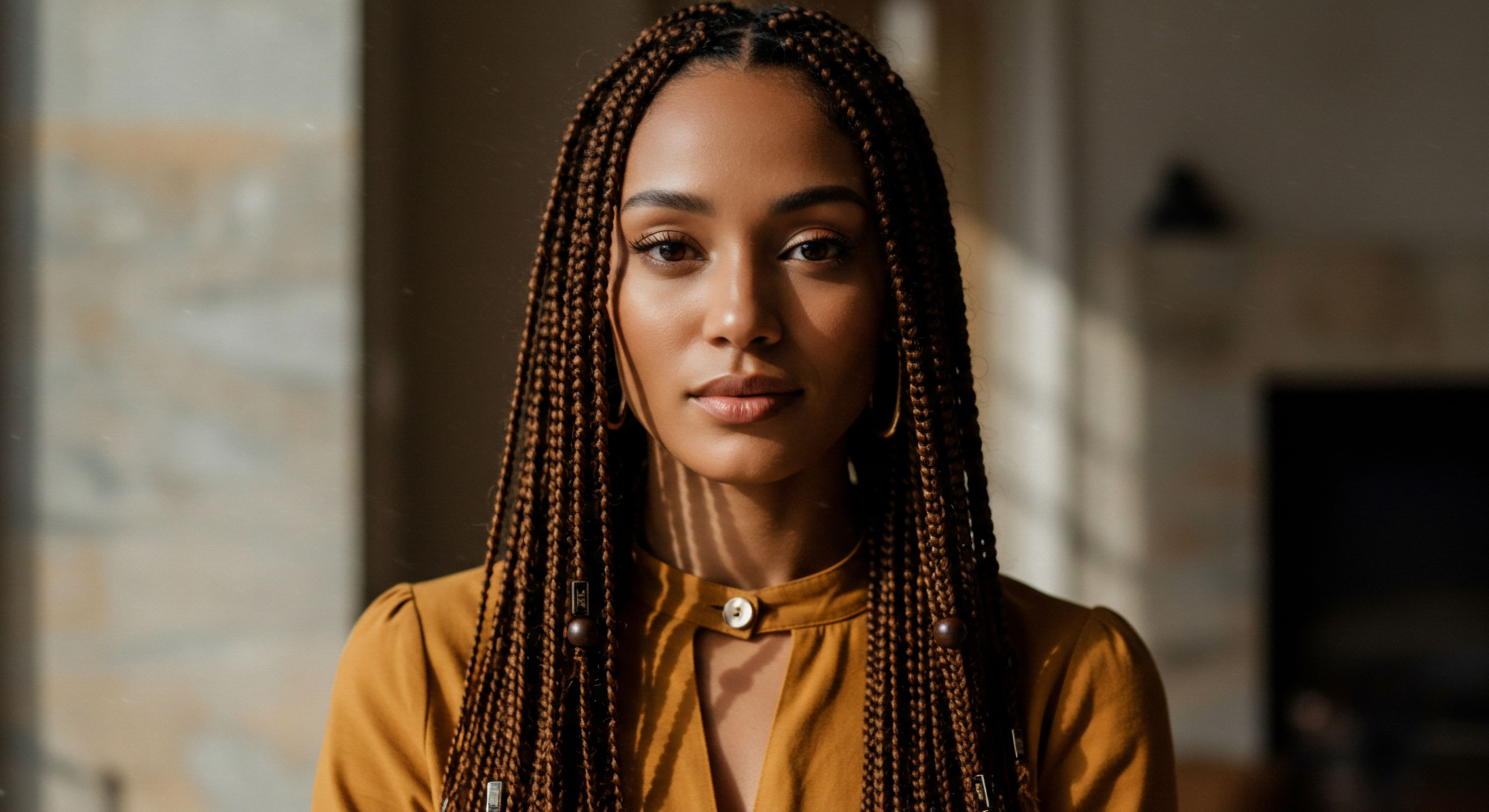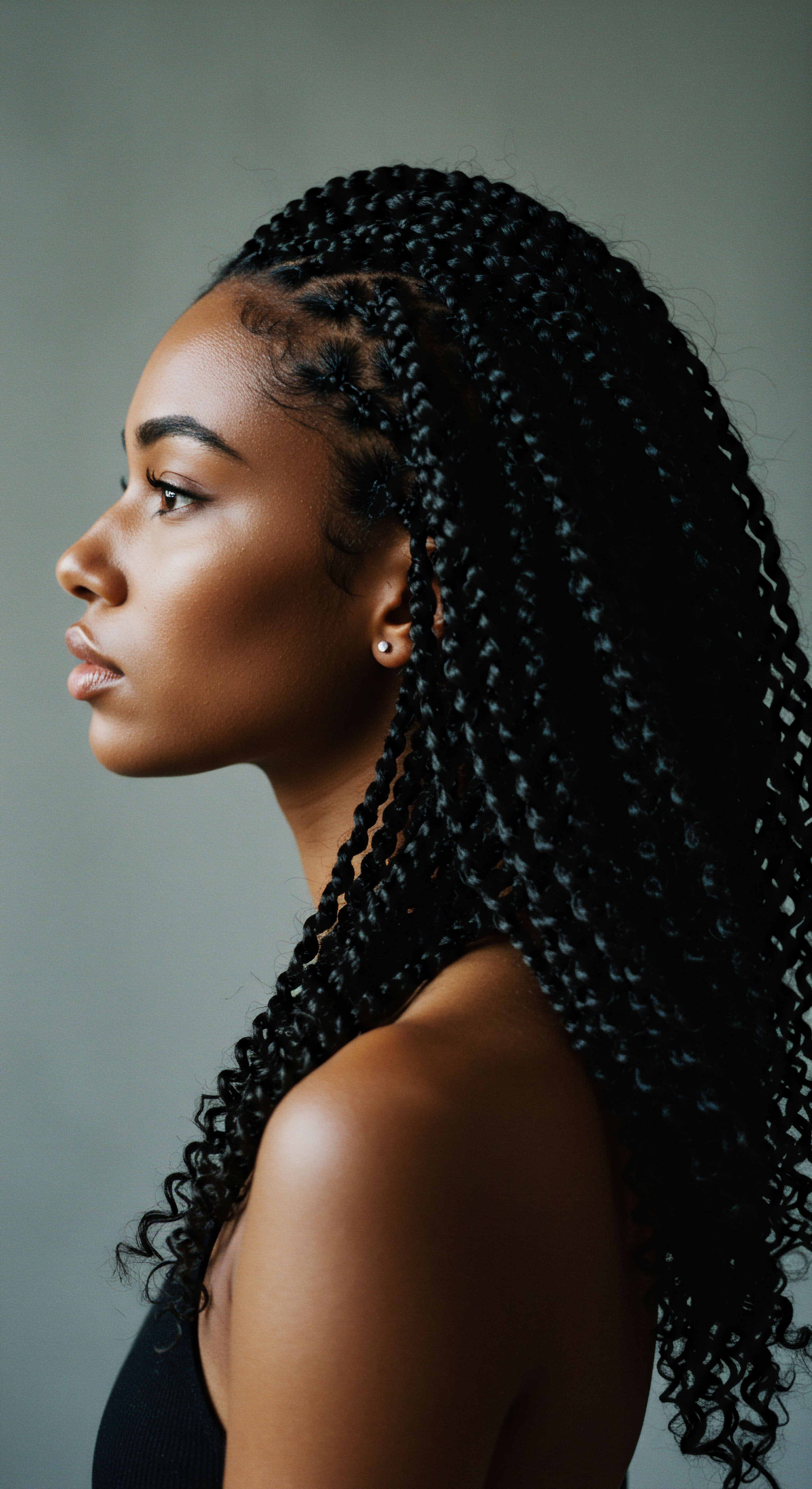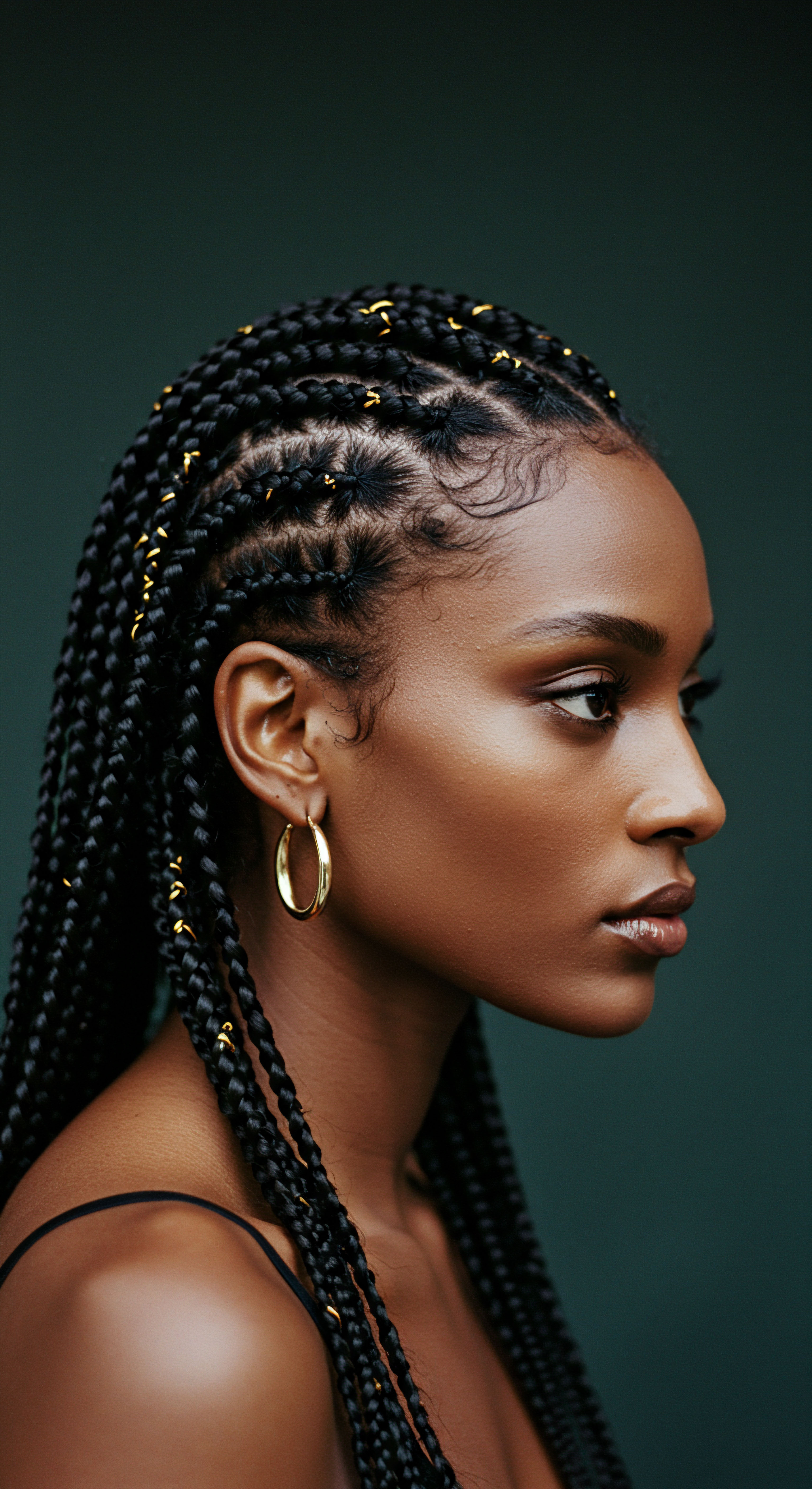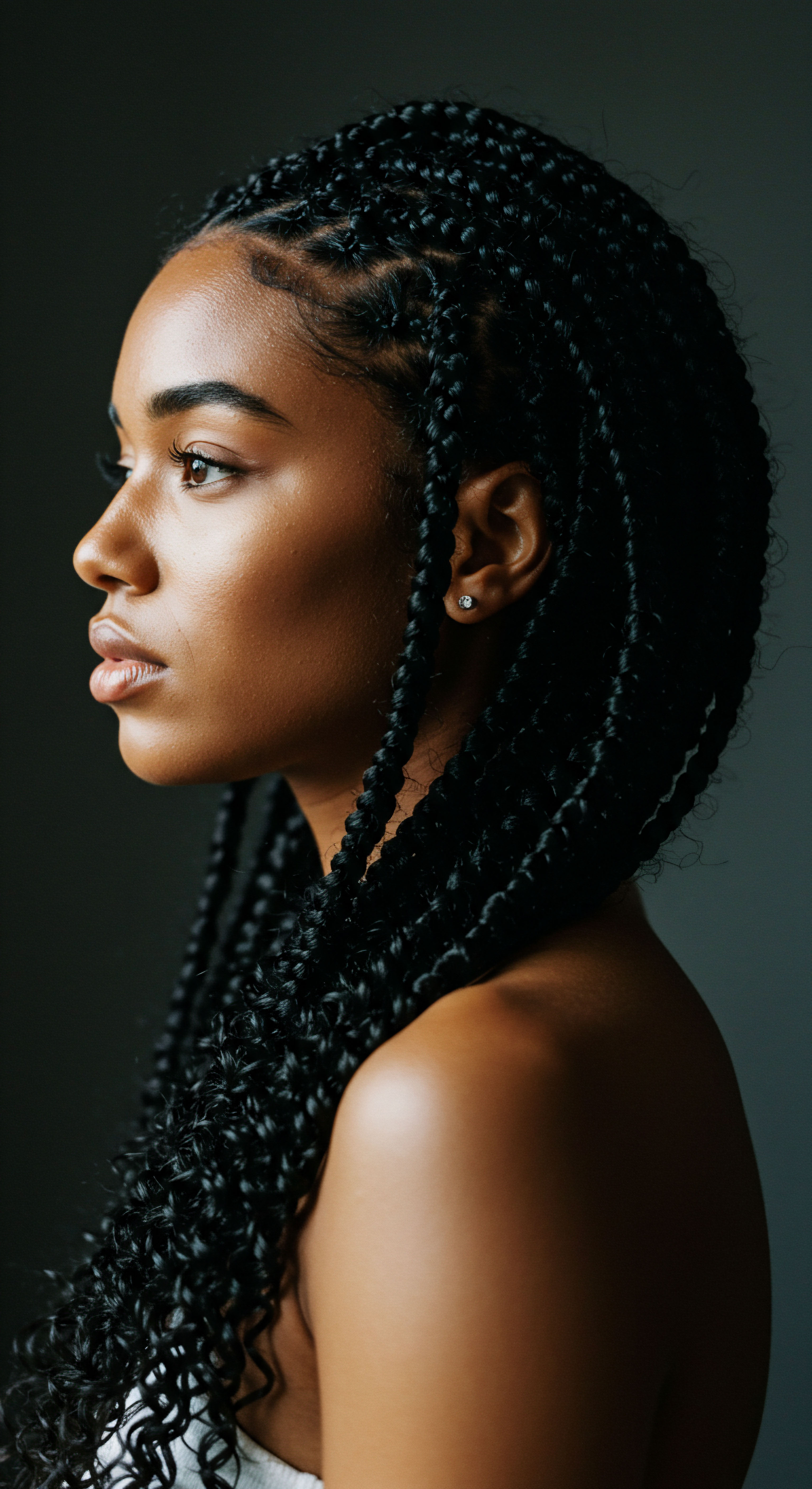
Roots
The stories held within textured hair are as ancient as the windswept sands of the Sahara, as deep as the waters of the Nile. When we consider the simple act of braiding, we are not simply observing a hairstyle; we are gazing upon a profound cultural expression, a language spoken across generations, long before written words chronicled human existence. Hair, particularly braided hair, served as a visual lexicon, a living document of societal structure in ancient African communities.
It was a crown, a map, a declaration, all wound into strands. This exploration begins at the very source, seeking to understand the foundational principles that elevated hair beyond mere adornment to a powerful marker of social standing.
For communities throughout Africa, hair held a sacred position. It was considered the most elevated part of the body, a conduit to the divine, a connection to ancestral wisdom. This spiritual connection imbued hair with a power that extended into daily life, making its care and styling acts of reverence.
The attention given to hair, the time invested in its creation, reflected a deep respect for both the individual and the collective. These practices were not fleeting trends but enduring customs, passed from elder to youth, from mother to child, ensuring the continuity of a shared cultural heritage.
Braids in ancient African societies were a profound visual language, conveying complex social information without uttering a single word.

Hair as an Identifier
In many ancient African societies, a person’s hairstyle could instantly convey a wealth of personal information. Before any spoken greeting, one might discern a person’s age, their marital status, their religious convictions, or even their ethnic origin simply by observing the patterns and adornments in their hair. This visual communication system was remarkably sophisticated, operating within a framework of shared understanding unique to each community. Different styles were exclusive to specific groups or life stages, making hair a living identification card.
Consider the Yoruba People of Nigeria, where hairstyles were not only aesthetically pleasing but also deeply symbolic. A Yoruba woman’s hair could communicate her marital status; specific styles were reserved for single women, while others were worn by those who had taken a spouse. The complexity and neatness of a style could also speak volumes about a woman’s overall well-being and diligence. An unkempt appearance might suggest distress or illness, highlighting the community’s collective concern for personal presentation as a reflection of inner state.
- Age Markers ❉ Young individuals often wore distinct styles to signify their youth, transitioning to more elaborate designs as they reached adulthood or entered new life phases.
- Marital Status ❉ Specific braiding patterns or the presence of certain adornments often indicated whether a person was single, married, widowed, or ready for courtship.
- Tribal Affiliation ❉ Each ethnic group or tribe often possessed unique braiding patterns that served as a clear identifier of one’s community.

The Spiritual Connection to Hair
Beyond social markers, hair possessed significant spiritual weight. Many African cultures believed hair acted as a direct line to the spiritual realm, a channel for receiving divine guidance and ancestral blessings. This belief elevated hairdressing to a sacred art, often performed by respected members of the community who possessed both skill and spiritual insight. The careful handling of hair, the precise placement of braids, and the incorporation of sacred objects were all part of a ritualistic process that honored this connection.
The Yoruba cosmology, for instance, views hair as a sacred medium, linking individuals to their ancestors and deities. The act of braiding could be seen as a way to send messages or prayers to the gods, making the head a focal point of spiritual energy. This reverence for hair meant its care was not merely about cleanliness or beauty, but about maintaining spiritual purity and alignment. Losing hair, or having it cut by an outsider, could therefore hold deep symbolic implications, representing a loss of power or connection.
Archaeological discoveries across Africa confirm the ancient origins of these practices. Rock paintings in the Sahara Desert, dating back to 3500 BCE, show depictions of women with cornrows, offering some of the earliest visual records of braided styles. Ancient Egyptian depictions also showcase elaborate hairstyles, with wigs and braids signifying both social position and religious beliefs. These historical artifacts confirm that hair adornment was a long-standing tradition, deeply woven into the fabric of daily life and spiritual practice.

Ritual
Moving beyond the foundational understanding of hair as a marker, we approach the realm of ritual, where the daily and periodic practices of hair styling shaped ancient African life. This is where the artistry of braiding truly came alive, transforming strands into stories, patterns into pronouncements. Here, we observe how techniques and methods, refined over centuries, became intertwined with rites of passage, communal gatherings, and the very rhythms of existence. It is a space where practical wisdom met profound meaning, where every parting and plait carried a purpose beyond mere appearance.
The creation of braided hairstyles was often a communal activity, a time for bonding and sharing stories. Family members, particularly women, would gather to braid each other’s hair, passing down techniques and cultural wisdom from one generation to the next. This shared experience strengthened social ties and ensured that the intricate knowledge of hair artistry remained within the community. The time involved in creating elaborate styles, often hours or even days, underscored the significance of the act itself, transforming it into a cherished social ritual.
The communal act of braiding served as a vital social ritual, reinforcing bonds and transmitting cultural knowledge across generations.

Braiding as a Rite of Passage
Hairstyles frequently marked significant life transitions, acting as visual cues for a person’s journey through different stages of existence. From birth to marriage, and even into elderhood or mourning, specific braided styles announced one’s new status to the community. These transformations were not merely cosmetic; they were deeply symbolic, representing a person’s changing responsibilities, privileges, and spiritual standing.
- Childhood to Adulthood ❉ Young women often wore elaborate braids during initiation ceremonies, signaling their readiness for adulthood and new societal roles.
- Marriage ❉ Certain styles were reserved for brides or married women, announcing their new status and often symbolizing fertility or domestic responsibilities.
- Mourning ❉ Periods of grief were sometimes marked by specific hair practices, such as cutting hair short or leaving it unstyled, to signify a state of bereavement and transformation.

How Did Specific Braiding Patterns Convey Social Position?
The specific patterns and designs within braids held precise meanings, communicating social position with remarkable clarity. These patterns were not arbitrary; they were codified expressions, understood by members of the society. The placement of cornrows, the number of braids, or the direction of a plait could all signify a person’s role within their community, their wealth, or their lineage.
For instance, the Himba People of Namibia are known for their distinctive hairstyles, which use a mixture of red ochre paste and butter. These styles are not just beautiful; they tell the story of a woman’s life stages. Young girls wear smaller braided sections, while adult women and mothers sport larger, more elaborate styles, reflecting maturity and fertility. This tradition ensures that a woman’s hair is a living testament to her journey and her place within the Himba social structure.
The time and resources required to maintain certain styles also played a role in conveying social standing. Highly complex styles, which took many hours to create and required the skill of a master braider, were often associated with wealth and leisure. A person able to dedicate such time and expense to their appearance implicitly signaled their economic standing. This is particularly evident in styles that incorporated precious materials.
| Community/Region Yoruba (Nigeria) |
| Braiding Style/Feature Irun Kiko (thread-wrapped) |
| Social Indication Femininity, marriage, coming-of-age |
| Community/Region Himba (Namibia) |
| Braiding Style/Feature Ochre-coated locs/braids |
| Social Indication Life stages, marital status, connection to earth |
| Community/Region Wolof (Senegal) |
| Braiding Style/Feature Partially shaved heads (young girls) |
| Social Indication Unavailability for courtship |
| Community/Region Ancient Egypt |
| Braiding Style/Feature Elaborate wigs with braids |
| Social Indication Wealth, religious devotion, higher social ranking |
| Community/Region South Africa (Box Braids) |
| Braiding Style/Feature Complex, time-intensive styles with adornments |
| Social Indication Wealth, readiness for marriage, economic status |
Beyond the aesthetic, the materials incorporated into braids also served as social markers. Beads, cowrie shells, gold, and other precious items were often woven into hairstyles, signaling the wearer’s wealth, status, or even spiritual protection. The more valuable the adornments, the higher the perceived standing of the individual. This practice transformed hair into a living display of accumulated resources and communal respect.

Relay
As we move deeper, the discussion of braids in ancient African societies ascends to a more sophisticated plane, where cultural intelligence converges with scholarly investigation. Here, we peel back layers to uncover the less apparent complexities, the intricate interplay of social, political, and spiritual factors that defined a person’s standing through their hair. This section bypasses surface-level descriptions, aiming for a profound grasp of how these practices functioned within a complex social matrix, drawing upon specific historical contexts and research.
The significance of hair in ancient African societies extended into the very core of governance and communal order. Hair was not merely a personal statement; it was a public declaration, a visual shorthand for one’s place within the established hierarchy. Leaders, warriors, and spiritual figures often bore distinct hairstyles that commanded respect and communicated their authority. These styles were meticulously maintained, reflecting the order and discipline expected of those in positions of influence.
Braids acted as a silent language of authority and belonging, reflecting the structured hierarchies of ancient African communities.

How Did Royal Hairstyles Signal Power?
Royal courts across ancient Africa employed elaborate hairstyles to distinguish monarchs and nobility from the general populace. These styles were often larger, more ornate, and incorporated symbols of sovereignty and divine connection. The complexity and grandeur of a royal hairstyle conveyed the ruler’s power, wealth, and proximity to the sacred.
Consider the Benin Kingdom, where the hairstyles of Bini Chiefs were powerful emblems of their connection to the Oba (King) and their high status. Two specific styles, Uguakpata and Ogbon, marked these royal chiefs. The Uguakpata adorned the frontal part of the head, a proud symbol of the chief’s revered status. The Ogbon, with its three vertical plaits at the back of the skull, further signified the chief’s deep connection to the traditions of the Benin royal palace.
These hairstyles were not chosen for personal preference; they were mandated symbols, part of a visual code that reinforced the kingdom’s political structure. The very arrangement of hair became a tangible representation of governance.
In the Meroitic Kingdom of Nubia, rulers like Queen Amanitore and King Natakamani are depicted with short hair, adorned with the double uraeus crown and other royal jewelry. While not always braided, their hair’s presentation, combined with specific regalia, served to assert their Kushite identity and royal status, placing them within a lineage of powerful rulers. This illustrates how even in societies where braiding was prevalent, other hair presentations could also convey supreme authority, often through their simplicity or specific symbolic additions.

The Societal Impact of Hair Practices
The societal impact of hair practices went beyond mere display; it permeated social interactions, economic activities, and even legal frameworks. The skill of a braider, for instance, was highly valued. In some cultures, these artisans held a respected position, their expertise essential for maintaining the visual markers of social order. The time and labor involved in creating complex styles also created a micro-economy around hair care.
A particularly compelling example of hair conveying social rank, sometimes controversially, arises from the historical context of the transatlantic slave trade. While this period marks a brutal disruption of African societies, it paradoxically highlights the deep-seated significance of hair as a communicative tool. Enslaved African women, despite facing immense oppression, continued to practice hair braiding. These braids, often cornrows, served a dual purpose ❉ a means of preserving cultural identity and, remarkably, a method of conveying secret messages and escape routes.
The patterns could map paths to freedom or indicate meeting points along the Underground Railroad. This subversive use of hair, transforming it into a clandestine communication system, underscores its profound symbolic power and its ability to subvert oppressive structures, even when stripped of traditional markers of rank. It reveals that even in the most dire circumstances, the inherent communicative capacity of braided hair persisted, shifting its meaning from overt status display to covert resistance.
The implications of hair practices extended to gender roles and communal expectations. For instance, among the Mende culture of Sierra Leone, thick, long, and well-maintained hair was a symbol of vitality and prosperity for both men and women. This collective aspiration for healthy hair underscored a shared cultural value, linking individual appearance to communal well-being and abundance. The expectation for hair to be clean, neat, and styled in culturally appropriate ways was a societal norm, with deviations sometimes interpreted as signs of distress or social neglect.
| Adornment Type Gold beads |
| Associated Meaning Wealth, royalty, divine connection |
| Societal Context Ancient Egypt, Benin Kingdom |
| Adornment Type Cowrie shells |
| Associated Meaning Prosperity, fertility, social standing |
| Societal Context Yoruba, Fulani, Himba |
| Adornment Type Feathers |
| Associated Meaning Warrior status, spiritual protection |
| Societal Context Various West African tribes |
| Adornment Type Clay/Ochre paste |
| Associated Meaning Connection to earth, life stages, cultural identity |
| Societal Context Himba people |

Beyond the Visual ❉ The Language of Hair Care
The act of caring for hair itself was a social indicator. The ability to dedicate hours, even days, to elaborate styling sessions, often involving multiple individuals, pointed to a person’s access to leisure and resources. This was not simply about having a beautiful hairstyle; it was about the communal time spent, the sharing of stories, and the reinforcement of social bonds during the process. The care rituals, including washing, oiling, and decorating hair with natural materials, were often public or semi-public events that reaffirmed social ties.
The very presence of specific tools, such as combs, pins, and razors, and the knowledge of their proper use, reflected a developed cultural practice around hair. These tools were not just functional items; they were extensions of a tradition, symbols of a society that valued and invested in its hair culture. The preservation of these tools through archaeological finds further confirms the historical depth of these practices.
The depth of understanding surrounding hair’s role in ancient African societies demonstrates a profound connection between the personal and the communal. Braids, in their countless variations, were a living testament to a complex social order, a silent yet powerful language that articulated status, identity, and belonging. This historical reality offers a rich perspective on the enduring significance of textured hair today, linking contemporary practices to a heritage of profound meaning.

Reflection
As we draw this exploration to a close, a profound truth emerges ❉ the strands of textured hair, when braided with intention, have always held stories far grander than mere aesthetic appeal. They are echoes of ancient wisdom, silent declarations of belonging, and living maps of a person’s journey through time and community. The practices of ancient African societies offer us a mirror, reflecting how deeply our outer expressions can speak of our inner worlds and our collective place. These historical insights invite us to consider the enduring power held within each coil and curl, reminding us that hair remains a vibrant, personal crown, a connection to a rich and living heritage.

References
- Byrd, Ayana D. and Lori L. Tharps. Hair Story ❉ Untangling the Roots of Black Hair in America. St. Martin’s Publishing, 2001.
- Chimbiri, K.N. The Story of Afro Hair ❉ 5,000 Years of History, Fashion and Styles. Scholastic, 2021.
- Omotos, Adetutu. “Hair was very important in ancient African civilizations.” Journal of Pan African Studies, 2018.
- Boone, Sylvia Ardyn. Radiance from the Waters ❉ Ideals of Feminine Beauty in Mende Art. Yale University Press, 1986.
- Davidson, Donald. Inquiries into Truth and Interpretation. Oxford University Press, 1984.
- Leach, Edmund. “Magical Hair.” Journal of the Royal Anthropological Institute of Great Britain and Ireland, vol. 88, no. 2, 1958, pp. 147–164.
- McIntosh, Peggy. “White Privilege ❉ Unpacking the Invisible Knapsack.” Peace and Freedom, July/August 1989, pp. 10-12.
- Nnoruka, E.N. “Hair Loss in African Women.” International Journal of Dermatology, vol. 44, no. 1, 2005, pp. 6-11.
- Török, László. The Image of the Ordered World in Ancient Nubian Art ❉ The Khartoum and Berlin Collections of the National Museum of Sudan. Brill, 2002.
- Török, László. The Kingdom of Kush ❉ Handbook of the Napatan-Meroitic Civilization. Brill, 2014.